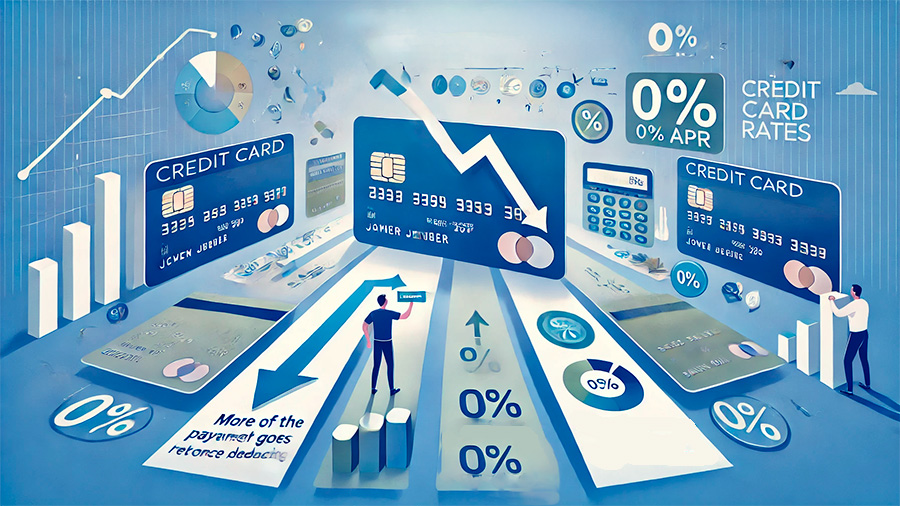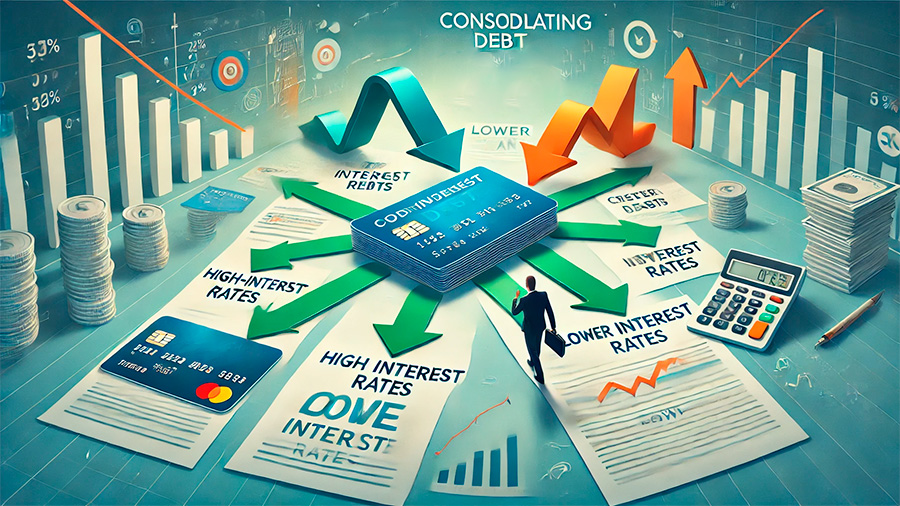When the Federal Reserve (Fed) lowers interest rates, it creates an opportunity for consumers to save money on borrowing costs. Lower Fed rates reduce the interest on various consumer loans, including mortgages, auto loans, personal loans, and credit card debt, making it more affordable to finance major purchases or consolidate existing debt. Understanding how these rate cuts affect your loans can help you capitalize on lower rates and make informed decisions about your borrowing needs. This guide explains how Fed rate cuts impact consumer loans and offers strategies for taking advantage of these lower interest rates.
Understanding the Federal Reserve’s Role in Interest Rates
The Federal Reserve sets the federal funds rate, which is the interest rate at which banks lend money to one another overnight. While this rate does not directly determine consumer loan rates, it influences the overall cost of borrowing throughout the economy. When the Fed lowers its benchmark rate, banks typically reduce the interest rates they charge consumers for various loans, making borrowing more affordable. This is done to stimulate economic activity by encouraging individuals and businesses to spend and invest.
For consumers, lower interest rates mean cheaper loans, which can help reduce monthly payments, lower the total cost of financing, and make it easier to access credit.
The Impact of Lower Fed Rates on Consumer Loans
Fed rate cuts lead to lower interest rates on a wide range of consumer loans, including mortgages, auto loans, personal loans, and credit card debt. Whether you’re planning to borrow for a major purchase or refinance existing debt, understanding how these loans are affected by rate cuts can help you make smart financial decisions.
Lower Mortgage Rates
One of the most significant benefits of a Fed rate cut is the impact on mortgage rates. When the Fed lowers interest rates, lenders often reduce the rates they offer on home loans, making it more affordable to buy a house or refinance an existing mortgage. A lower mortgage rate can result in substantial savings over the life of the loan, as even a small decrease in the interest rate can lead to lower monthly payments and reduced overall interest costs.
For example, if you have a 30-year fixed mortgage, a rate reduction of just 1% can save you thousands of dollars in interest payments over the term of the loan. Additionally, lower rates may make it easier for first-time homebuyers to qualify for a mortgage, as the reduced payments can improve affordability.
Cheaper Auto Loans
Auto loans are another type of consumer loan that benefits from lower Fed rates. When interest rates drop, car buyers can take advantage of lower financing costs, reducing the monthly payments on new or used vehicles. Whether you’re purchasing a new car or refinancing an existing auto loan, lower interest rates can make the purchase more affordable and help you save money over the life of the loan.
Auto manufacturers and dealers may also offer promotional financing deals, such as 0% interest rates, during periods of low Fed rates. These deals provide an excellent opportunity to finance a vehicle at minimal cost, allowing you to pay off the car without incurring significant interest charges.
Personal Loan Savings
Personal loans, often used for consolidating debt, covering emergency expenses, or financing home improvements, also become more affordable when the Fed lowers rates. Since personal loans typically have higher interest rates than secured loans like mortgages or auto loans, any reduction in rates can lead to meaningful savings. Lower personal loan rates mean smaller monthly payments and reduced overall borrowing costs, making it easier to manage debt or finance large expenses.
Additionally, if you have an existing personal loan with a high interest rate, refinancing to a lower rate during periods of low Fed rates can help reduce your payments and save on interest.
Credit Card Debt and Lower Fed Rates
While most consumer loans have fixed interest rates, credit cards often have variable rates tied to the prime rate, which is influenced by the Fed’s rate changes. When the Fed cuts rates, the interest rates on many credit cards tend to decrease as well, offering an opportunity to save on interest costs if you carry a balance.

How to Take Advantage of Lower Credit Card Rates
- Pay down existing balances: When credit card rates decrease, more of your monthly payment goes toward paying off the principal, rather than interest. This can help you pay down balances faster.
- Consider a balance transfer: Many credit cards offer promotional balance transfer rates, including 0% APR for a limited time. During periods of low Fed rates, these offers become more common, providing a chance to consolidate high-interest debt and save on interest charges.
- Monitor your interest rates: If your credit card has a variable rate, you may notice a decrease in your interest charges after a Fed rate cut. Take advantage of this by making larger payments to reduce your balance faster.
Lower Fed rates make it easier to manage credit card debt, especially if you’re carrying high balances. By paying down debt during these periods, you can reduce your overall financial burden and improve your credit profile.
Refinancing Loans to Capitalize on Low Fed Rates
One of the best ways to take advantage of lower Fed rates is by refinancing existing loans. Refinancing involves replacing your current loan with a new one at a lower interest rate, reducing your monthly payments and total interest costs. Refinancing is particularly beneficial for large loans, such as mortgages, auto loans, and personal loans, where even a slight reduction in the interest rate can result in significant savings.
Refinancing a Mortgage
Mortgage refinancing is one of the most popular ways to benefit from lower Fed rates. By refinancing your home loan at a lower rate, you can reduce your monthly mortgage payments, lower your total interest costs, and potentially shorten your loan term. Many homeowners refinance when interest rates drop by at least 1%, but even smaller reductions can make a difference, especially for larger loans.
When considering refinancing, it’s essential to account for closing costs and fees, which can offset some of the savings. However, if you plan to stay in your home for several more years, the long-term savings typically outweigh the upfront costs.
Refinancing Auto Loans and Personal Loans
If you’re paying a high interest rate on an auto loan or personal loan, refinancing can also help reduce your payments. During periods of low Fed rates, lenders often offer competitive refinancing deals that allow borrowers to lock in lower rates. By refinancing, you can reduce your interest costs and free up cash flow for other financial goals.
For auto loans, refinancing is often quick and easy, and it can save you a significant amount of money, particularly if you financed your vehicle at a higher rate. Personal loan refinancing may also provide relief if you’ve taken out a loan at a time when rates were higher.

Consolidating Debt at Lower Interest Rates
Low Fed rates create an opportunity for consumers to consolidate high-interest debt into a single loan with a lower interest rate. Debt consolidation can simplify your finances and reduce your overall interest costs, making it easier to pay off your debt faster. This strategy is particularly effective for credit card debt, which often carries higher interest rates than other forms of borrowing.
Benefits of Debt Consolidation
- Lower interest rates: Consolidating high-interest debt into a lower-interest loan helps you save on interest charges over time.
- Simplified payments: Instead of managing multiple debt payments each month, consolidation allows you to focus on a single payment, reducing the risk of missed payments.
- Faster debt repayment: By reducing your interest costs, more of your monthly payment goes toward paying down the principal, helping you eliminate debt faster.
During periods of low Fed rates, many lenders offer attractive debt consolidation options, including personal loans with lower rates and promotional credit card balance transfers.
Strategies for Taking Advantage of Lower Fed Rates
To make the most of lower Fed rates, it’s essential to have a clear plan for your borrowing and refinancing needs. Here are some strategies to help you take full advantage of reduced interest rates:
- Shop around for the best rates: Even during periods of low Fed rates, different lenders may offer varying interest rates. Compare multiple offers from banks, credit unions, and online lenders to ensure you’re getting the best deal.
- Consider your credit score: Your credit score plays a crucial role in the interest rates you’ll qualify for. Before applying for new loans or refinancing, check your credit score and take steps to improve it if necessary.
- Act quickly: When the Fed cuts rates, it often triggers a rush of refinancing and new loan applications. Acting quickly allows you to lock in a lower rate before lenders adjust their offerings or increase fees.
- Don’t overextend yourself: While lower rates make borrowing more affordable, it’s important to avoid taking on too much debt. Ensure that your monthly payments remain manageable, even with the reduced interest costs.
By following these strategies, you can take advantage of lower Fed rates to reduce your borrowing costs and improve your overall financial health.
Conclusion: Saving on Loans with Lower Fed Rates
Lower Fed rates offer a valuable opportunity for consumers to save on a wide range of loans, from mortgages and auto loans to personal loans and credit card debt. By understanding how these rate cuts affect your borrowing options and using strategies like refinancing, debt consolidation, and rate shopping, you can reduce your interest costs and free up cash flow for other financial goals. Whether you’re planning to make a major purchase or manage existing debt, taking advantage of low interest rates can lead to significant savings and help you build a more secure financial future.

